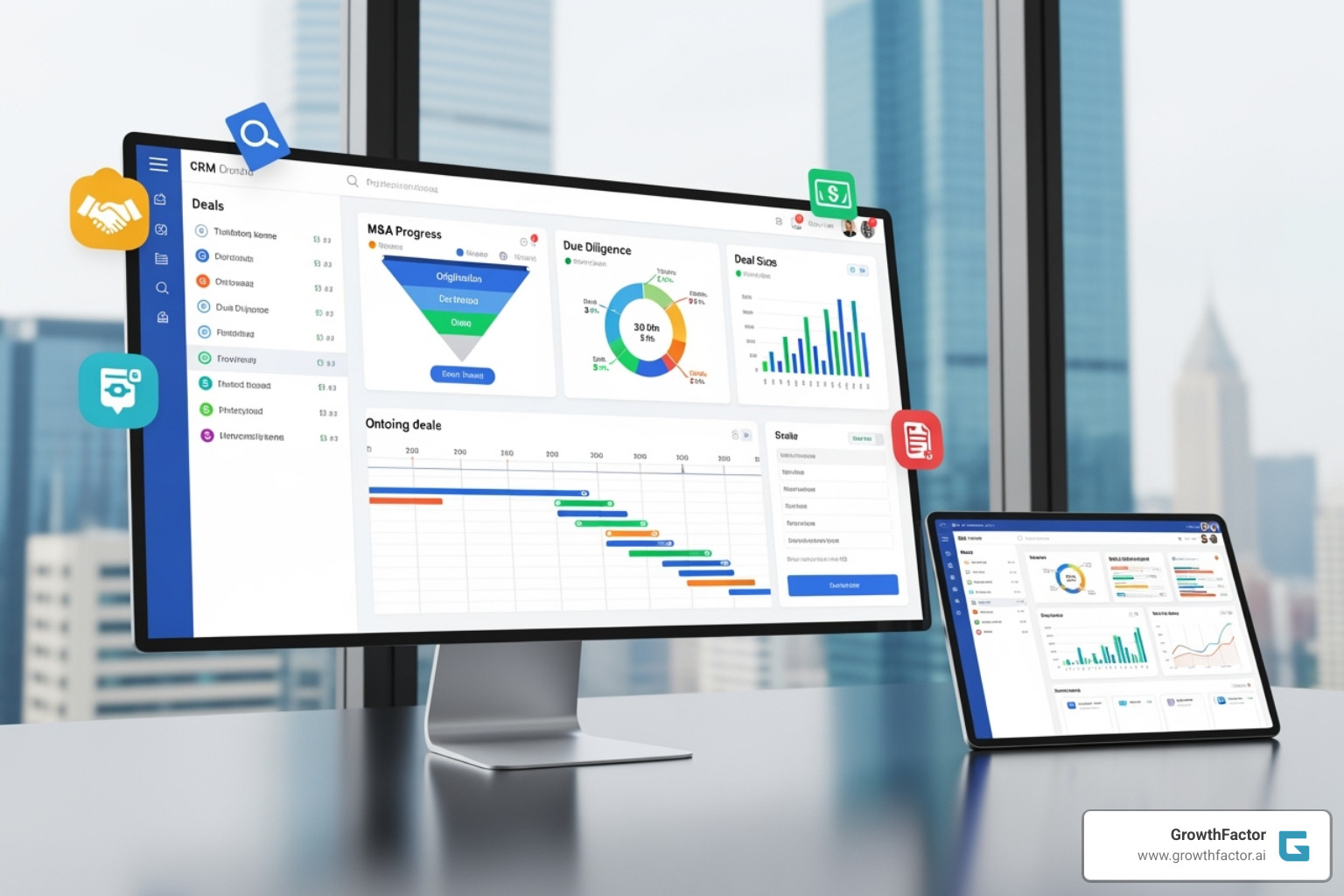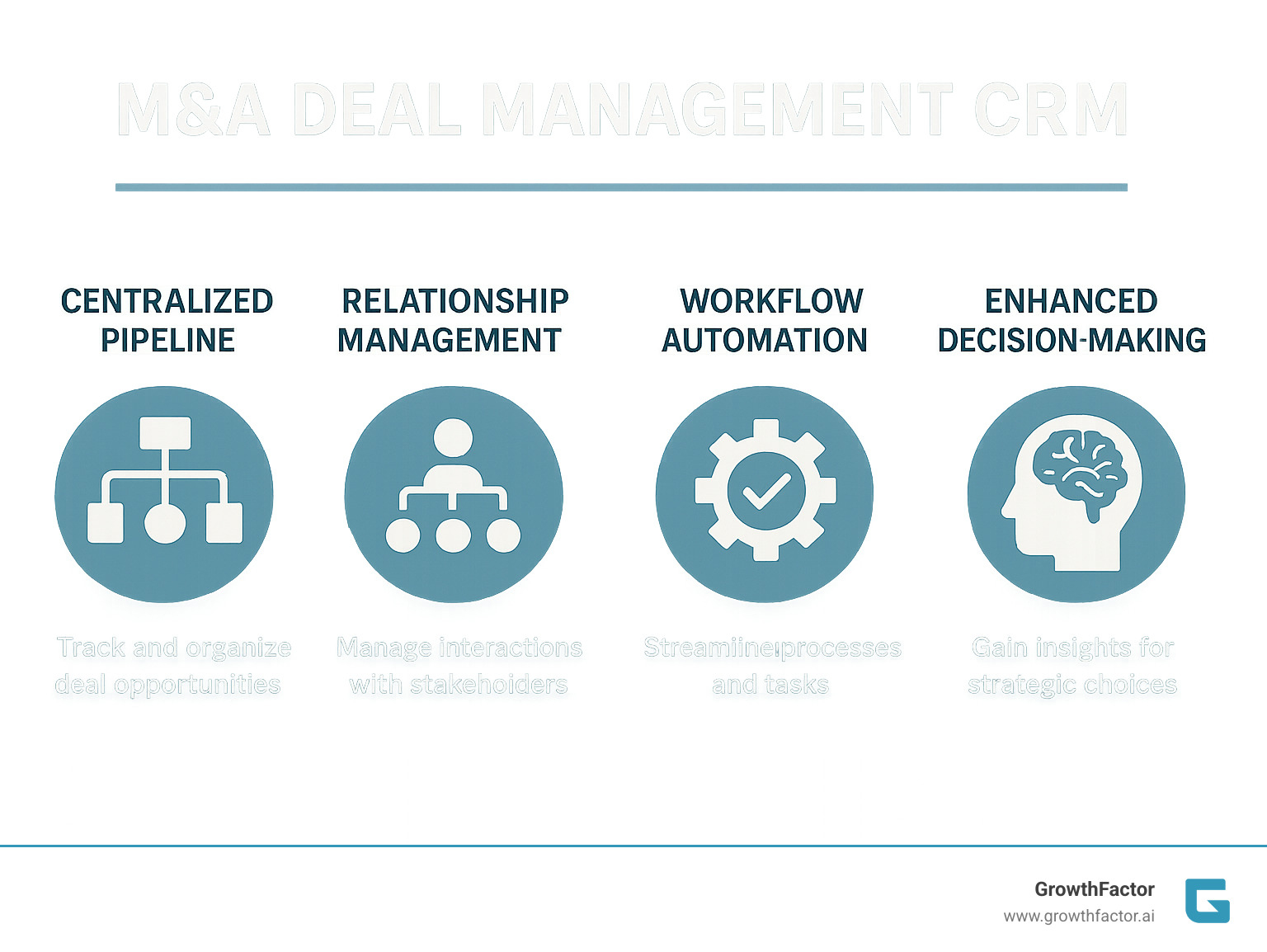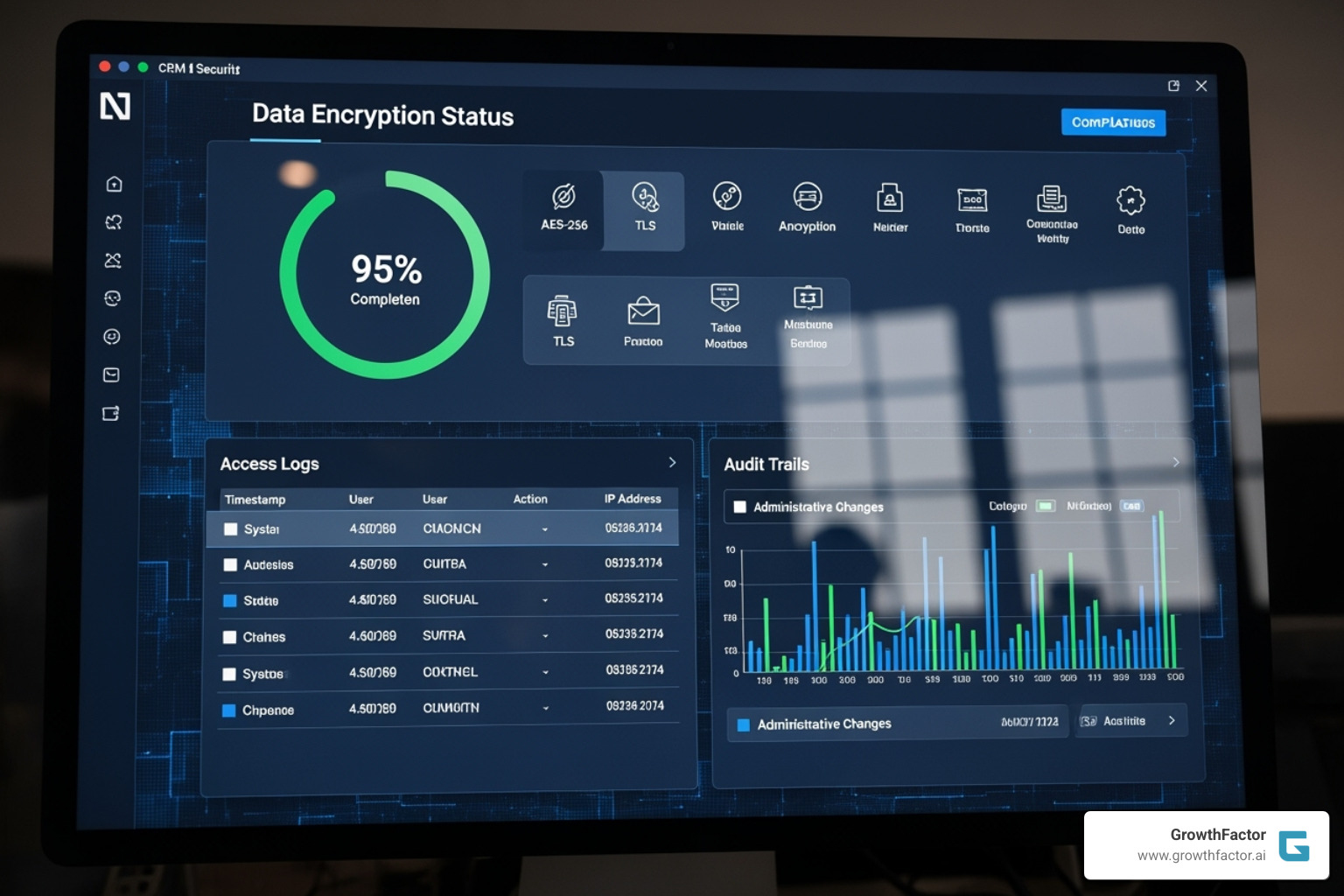The Definitive Guide to M&A Deal Management CRM
Written by: Clyde Christian Anderson
Why a Specialized M&A Deal Management CRM is Crucial Today

In today's complex financial landscape, a specialized m&a deal management crm is an essential tool for any firm involved in mergers and acquisitions. This software is designed to address the unique challenges of M&A professionals. Key functions include:
- What is an M&A Deal Management CRM?
- It's a specialized software solution built for M&A professionals.
- It helps manage all interactions with clients, partners, and other stakeholders.
- It tracks leads, deals, and communication history in one place.
- It stores and shares important documents securely.
- It centralizes your entire deal pipeline and relationship data for better organization.
Mergers and acquisitions are high-stakes, fast-moving, and complex. Managing these deals with outdated tools like spreadsheets or generic CRMs often leads to disorganization, missed opportunities, and delays. A purpose-built M&A CRM resolves these issues by streamlining deal flow, centralizing data, and providing real-time visibility into your pipeline.
I'm Clyde Christian Anderson, CEO of GrowthFactor.ai. My experience in investment banking and retail real estate deal management led me to create solutions that simplify the intricate processes M&A professionals face, enabling them to make faster, data-driven real estate decisions.

What is an M&A CRM and Why Is It Essential for Dealmakers?
Mergers and acquisitions are complex, high-stakes endeavors in investment banking and corporate development. They involve long deal cycles, multiple concurrent deals, and intricate relationship networks. Without proper tools, deal teams can become overwhelmed by data, miss critical details, and lose sight of opportunities.
An m&a deal management crm serves as a firm's single source of truth, centralizing all deal-related information. This eliminates information silos and ensures team alignment, which is critical when stakes are high.
Defining an m&a deal management crm
At its core, an M&A CRM is a specialized software solution built for the project-based workflows of M&A professionals. Unlike general-purpose CRMs, it is designed to manage interactions with clients, partners, and stakeholders throughout the M&A process. It tracks leads, deals, and communication history, while securely storing important files. This centralized platform streamlines workflows and improves team collaboration, managing the entire M&A pipeline from origination to close. If you're curious about how this fits into the broader picture of deal tracking, you can learn more about M&A Deal Tracking Software.
The Critical Difference: M&A CRM vs. General-Purpose CRM
Many firms still rely on general-purpose CRMs built for traditional sales funnels, but these platforms are designed for linear, transactional processes. M&A processes, by contrast, are non-linear, relationship-driven, and can span years. Traditional CRMs are a poor fit for M&A because they lack functionalities for:
- Non-linear processes: M&A deals frequently pause, pivot, or backtrack. General CRMs cannot adapt to these dynamic flows.
- Complex stakeholder networks: M&A involves a wide ecosystem of professionals. A specialized CRM is built to manage these intricate relationships.
- Relationship intelligence: In M&A, trusted relationships are critical. A purpose-built CRM maps and leverages these networks, often by automatically capturing communication data.
- Project management capabilities: M&A deals require detailed task tracking, due diligence management, and post-merger integration oversight, which are beyond the scope of typical sales CRMs.
As one expert noted, "Traditional sales funnel software is not suitable for modern investment banking M&A processes." Investing in a CRM that aligns with the unique demands of M&A is a direct investment in your firm's success.
What Are the Key Features of an M&A Deal Management CRM?
An effective m&a deal management crm provides powerful functionalities designed to optimize M&A workflows. These platforms offer essential features that are indispensable for dealmakers.

A core feature is robust pipeline management. This provides a dynamic, visual roadmap of all deals, often using Kanban boards with customizable stages. This allows teams to track opportunities from origination to close and use deal scoring to prioritize high-potential prospects.
Automated data capture is another critical feature. Top-tier M&A CRMs sync with emails and calendars to log interactions automatically, enriching contact and company records without manual entry. This minimizes human error and frees up professionals for strategic tasks.
Relationship intelligence and network mapping are also vital. These tools help track and measure interactions to identify the strongest connections to potential buyers, investors, or clients, accelerating deal sourcing and execution.
Other key features include:
- Task automation and workflow templates: Streamline repetitive tasks and ensure process consistency across all deals.
- Centralized document management: Provides a secure environment for sharing sensitive information, attaching due diligence documents, and maintaining a clear audit trail.
- Advanced reporting and real-time analytics: Customizable dashboards and KPIs offer clear insights into the business development pipeline, enabling faster, data-driven decisions.
- Robust security: M&A data requires paramount security. Look for features like industry-standard certifications such as SOC 2, role-based access, and encrypted servers to ensure data privacy and compliance.
- API and integration capabilities: The CRM should integrate seamlessly with other essential tools like virtual data rooms (VDRs), financial data systems, and market intelligence platforms to create a unified M&A ecosystem.
How a CRM Supports the Entire M&A Deal Lifecycle
An m&a deal management crm is a strategic partner that provides control and visibility across the entire M&A deal lifecycle, changing how teams execute transactions.
Stage 1: Deal Sourcing and Origination

In the initial stage, an M&A CRM is instrumental for finding opportunities. It helps identify and track potential targets and leverage relationship intelligence to secure warm introductions to sellers or investors. At GrowthFactor, our AI Agent Waldo automates the qualification and evaluation processes for potential sites, enabling our teams to evaluate five times more sites efficiently. This automation helps find higher-quality opportunities faster while organizing initial outreach and contact management.
Stage 2: Due Diligence and Evaluation
During due diligence, the CRM acts as a command center. It allows you to centralize all diligence documents securely with version control and access permissions. The platform helps manage checklists, track requests, and facilitate secure collaboration among legal, financial, and operational teams. It also logs all communications, creating a clear audit trail and allowing teams to focus on analysis rather than administration. For more details, see our guide on Deal Tracking Software.
Stage 3: Negotiation and Closing
Precision is key during negotiations. An M&A CRM helps track deal terms and manage agreement versions. It logs all key communications to create a historical record of discussions and decisions. The CRM also streamlines internal approvals, ensuring all internal and external stakeholders are aligned for a smooth closing process and reducing the risk of last-minute issues.
Stage 4: Post-Merger Integration (PMI)
A deal's success is often determined by post-merger integration. While GrowthFactor focuses on pre-deal and active deal stages, a CRM provides critical support for PMI. It can be used to:
- Track integration tasks: Assign and monitor all tasks, from system mergers to team onboarding.
- Monitor synergy realization: Track KPIs to ensure the projected value of the merger is being realized.
- Manage new teams and processes: Assist with onboarding, knowledge sharing, and implementing new procedures.
- Report on PMI progress: Provide regular updates to leadership on integration status.
By supporting the entire lifecycle, an M&A CRM ensures a firm's investment in a deal is maximized.
The Primary Benefits for Your Firm
Implementing a dedicated m&a deal management crm delivers tangible results by fundamentally improving how your firm operates and competes.
Increased Efficiency and Productivity
Automating manual data entry and repetitive tasks saves hundreds of hours annually. Some platforms reduce document analysis time by up to 90%, allowing analysts to focus on high-value activities like strategic analysis and relationship building. This shift from administrative work to strategic focus increases overall productivity and deal-closing capacity. For more insights on how software can transform your M&A processes, check out our guide on Business Management Software M&A.
Improved Collaboration and Visibility
An M&A CRM eliminates information silos by creating a single source of truth. With universal access to real-time deal status, next steps, and responsibilities, team collaboration is transformed. This improved visibility and communication between departments and external advisors leads to more informed, productive conversations. Some firms report up to an 85% increase in employee engagement with the right tools and information.
Data-Driven Decision-Making
Successful M&A decisions rely on data, not intuition. A CRM provides actionable insights through comprehensive analytics and pipeline visibility. Robust reporting helps identify bottlenecks early, allowing for proactive measures. Improved forecasting accuracy based on real data enables more reliable predictions about deal timelines, resource allocation, and potential outcomes, allowing firms to react quickly to market changes.
Reduced Risk and Improved Compliance

A dedicated CRM mitigates the significant risks inherent in M&A. Centralized audit trails automatically log every action and communication, ensuring accountability and simplifying compliance reporting. Secure data handling and storage with enterprise-grade security protects sensitive information. Role-based permissions control information access, maintaining confidentiality. This structured approach can lead to a 5x reduction in missed details and ensures regulatory compliance, providing peace of mind during high-value transactions.
How to Choose the Right Platform for Your Needs
Selecting the right m&a deal management crm is a critical decision that requires a careful evaluation of your firm's specific needs and goals. The key is to know what to look for and ask the right questions.
Your Checklist for Choosing an m&a deal management crm
Focus on these criteria during your evaluation:
- Ease of use and user adoption: An intuitive interface is crucial. If a CRM is too complex, your team won't use it, negating the investment.
- Customization and flexibility: The platform should adapt to your firm's unique workflows, not force you to change them.
- Implementation timeline and support: Consider how quickly you need to see results and whether the vendor provides expert M&A-specific onboarding.
- Integration with your existing technology stack: Seamless integration with VDRs, financial systems, and communication tools is essential for a unified workflow.
- Scalability to handle future growth: Ensure the CRM can grow with your firm and increasing deal volume.
- Vendor's industry expertise: Choose a provider that understands the nuances of M&A and can offer strategic guidance.
- Transparent pricing and total cost of ownership: Understand all costs involved. At GrowthFactor, we offer clear pricing with our Core ($500), Growth ($1,500), and Enterprise plans.
Key Questions to Ask Providers
When speaking with vendors, ask targeted questions:
- "What is the typical onboarding process?" Inquire about data migration, team training, and ongoing support.
- "How do you handle data migration?" A good provider should make the transition from your old system seamless.
- "What level of customization can we do ourselves?" Determine if you can make adjustments internally or if you'll need to rely on their professional services.
- "Can you share examples of your reporting capabilities?" Ask to see sample dashboards and reports to ensure they meet your needs.
- "What are your security certifications?" This is non-negotiable. Inquire about standards like SOC 2 to ensure your data is protected.
Using this framework will help you select a CRM that supports your operational and strategic goals, making it a valuable investment in your firm's future.
Frequently Asked Questions about M&A CRM
Here are answers to common questions about M&A CRMs.
How is an M&A CRM different from a private equity CRM?
While there is significant overlap, the two have different primary focuses. An m&a deal management crm is typically built for a broader range of transactions, serving investment banks, corporate development teams, and advisory firms. The goal is to manage the entire deal lifecycle. A private equity CRM places a stronger emphasis on proprietary deal sourcing, fundraising, LP relationship management, and portfolio company oversight. However, core functions like pipeline management and contact tracking are essential for both. GrowthFactor's solutions are designed to serve these nuanced needs, whether for broad M&A or for optimizing Private Equity Portfolios.
Can a small advisory firm or a solo dealmaker benefit from an M&A CRM?
Absolutely. A dedicated M&A CRM can be highly impactful for smaller firms and solo dealmakers. It allows them to operate with the efficiency and professionalism of larger institutions. A CRM provides the structure to manage complex processes, maintain a professional brand, and ensure no details are missed, which is critical when resources are limited. It effectively amplifies a small team's capabilities, allowing them to compete and scale.
What is the biggest mistake firms make when implementing a CRM?
The most common mistake is a lack of planning and failure to drive user adoption. Simply buying the software is not enough. Common missteps include:
- Ignoring existing processes: Forcing unique workflows into a generic CRM leads to frustration and inefficiency.
- Failing to define clear goals: Without clear objectives, the CRM will not become the strategic asset it should be.
- Insufficient training and support: Without proper training and a clear understanding of its value, teams will revert to old methods like spreadsheets.
A successful implementation requires a change in both technology and process. This involves mapping workflows, customizing the CRM to solve specific problems, and providing thorough, ongoing training and support.
Conclusion
In today's competitive M&A landscape, managing complex deals with spreadsheets is no longer viable for serious professionals. A purpose-built solution is required.
An m&a deal management crm is a foundational technology that boosts efficiency, improves collaboration, and provides the data-driven insights needed to close more deals, faster. By centralizing the entire deal lifecycle, from sourcing to post-merger integration, these platforms free your team to focus on strategic goals and maximizing transaction value.
For firms in specialized sectors like retail real estate, the right platform is transformative. The addition of AI, a core component of GrowthFactor's platform, provides a significant competitive advantage through improved site selection and deal evaluation.
At GrowthFactor, we build solutions to help teams master their growth with advanced, data-driven tools. Ready to optimize your deal flow and realize your firm's full potential? Find how to optimize your deal flow and open up your firm's full potential.
Citations
The human algorithm
Request Your demo
Schedule meeting
Or submit your information below and we'll be in touch to schedule.


